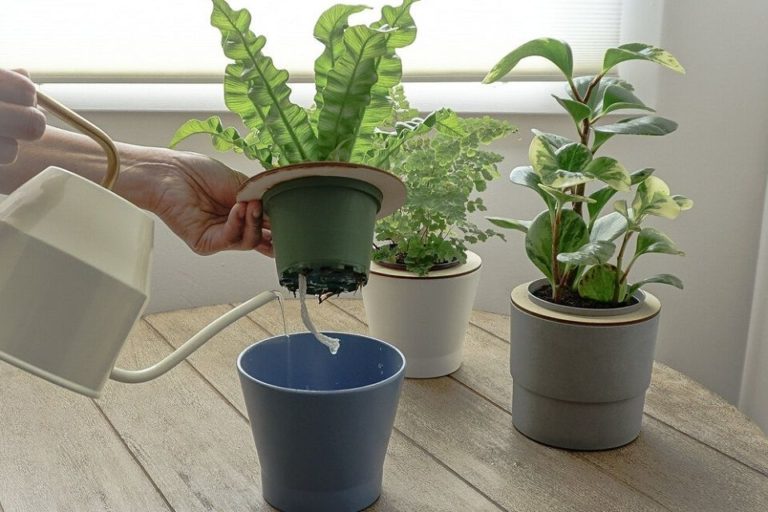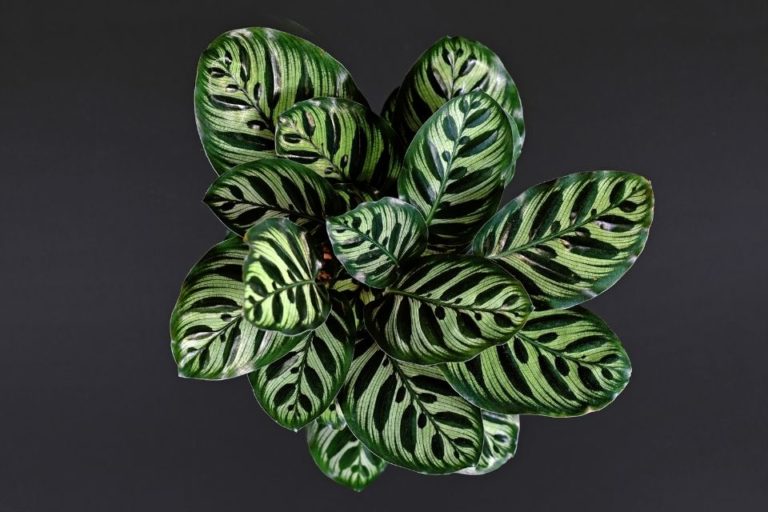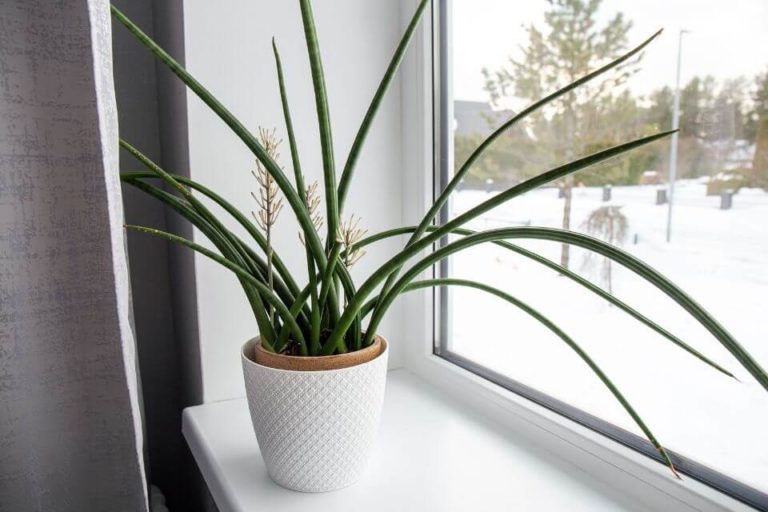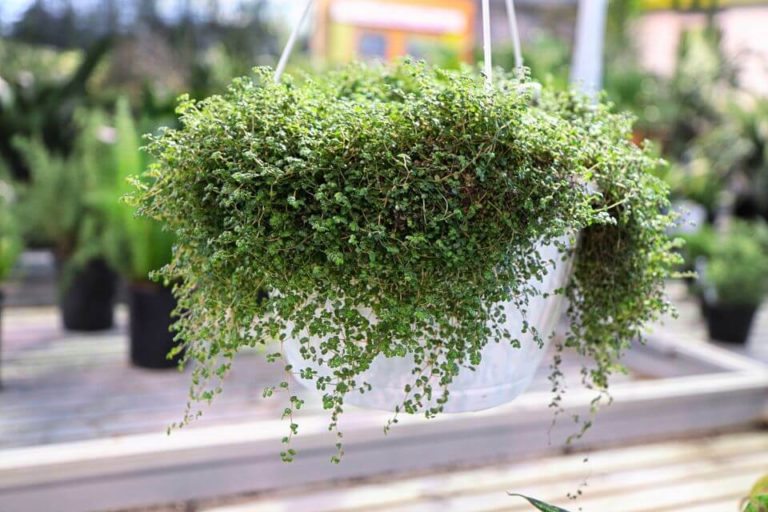Monstera Adansonii Care (Swiss Cheese Plant)-Grow & Propagation Guide
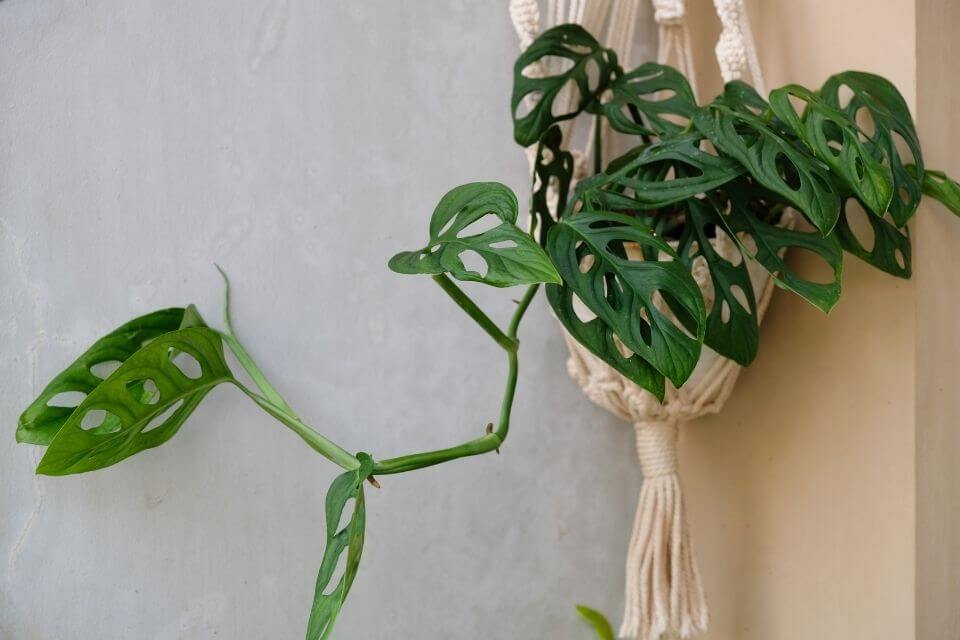
Monstera Adansonii is a plant characterized by large and heart-shaped leaves that usually develop holes as the plant grows. The holes on the leaves make it look like Swiss cheese.
The plant can grow fast in the wild; however, you can control its growth if you put it in containers. You can set the plant in nursery containers to make it easier to maintain its growth.
You can use the plant for both indoor and outdoor mostly for decorative purposes, provided you provide favorable conditions for its development.
People use the plant to decorate their homes since it has nice looks that may increase your living room aesthetic and make your house attractive.
| Highlights: | |
|---|---|
| Common Names: | Monstera Adansonii, Swiss Cheese Plant, Adanson's Monstera, Five Holes Plant |
| Botanical Name: | Monstera adansonii |
| Plant Family: | Araceae |
| Plant Type: | Tropical perennial |
| Origin/Native: | Tropical lands of Central and Sought America |
| Care Level: | Easy |
| Grow Zone: | 10A - 11 (USDA Hardiness Zone) |
| Size: | Rise up to 10 - 13 feet outdoors, up to 3 to 8 feet indoors, spread is 1 - 3 feet |
| Soil Requirement: | Light and well-draining soil with low pH levels |
| Water Requirement: | Medium moisture levels |
| Sun/Lighting: | No direct sunlight, but require bright light |
| Temperature Req: | 60 - 80 °F (15 - 27°C) |
| Propagation: | Stem cutting |
| Toxicity: | Toxic to animals and humans when swallowing |
| Flowering/Color: | Cream-colored flower with hints of purple |
| Uses: | House plant for decorative purposes, Remedi value, May use remedial purposes to Boils Treatment |
TABLE OF CONTENTS
Monstera Adansonii Overview
Monstera adansonii is also known as Swiss Cheese Plant an evergreen and climbing plant that produces long stems. The seed usually germinates from the soil until it reaches the top and attaches itself when it finds a woody plant.
The plant produces flowers, and bees are the pollinators. It acquired the name Swiss Cheese due to the large and heart-shaped leaves. The Swiss Cheese plant undergoes a fenestration process where the leaves start developing holes as it ages.
The plant is usually used as a house plant in Native, Central, and South America. The plant usually does well in moist and well-drained soils, and it is perennial.
Monstera Adansonii Size, Spread, and Appearance
Monstera Adansonii can grow between 10 to 13 feet tall if placed outdoors. It will climb up to 3 to 8 feet when you put it indoors, and a width of 1 to 3 feet when it matures.
The evergreen leaves of the plant can spread up to 20 to 30 inches long if the plant is grown under favorable conditions. Holes in the leaves assist them in resisting high winds and spreading to a length size that they want.
The leaves do not take much space in the house compared to other plants.
The most common feature of the plant is the heart-shaped leaves that are large and attractive. The leaves have more holes that allow air to get in for better circulation as it grows bigger.
The plant has aerial roots that make it easier to climb on other woody plants for stability if it grows bigger. It becomes easy to identify the evergreen plant due to its unique characteristics from other plants.
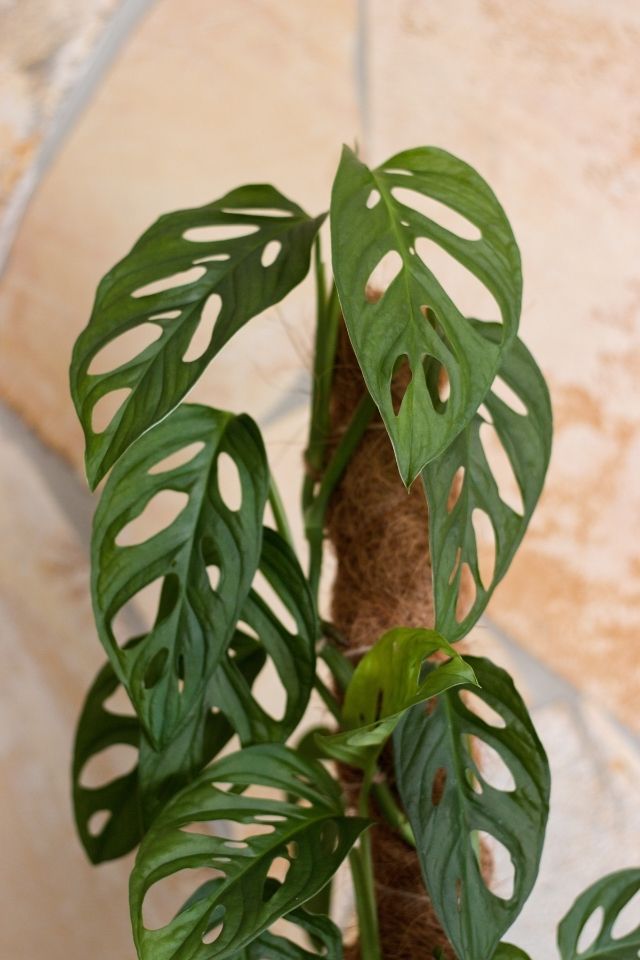
Uses of Monstera Adansonii Plant And Placements
The Swiss Cheese plant is harvested for use remedial purposes to Boils Treatment. You can crush the leaves and apply them to the affected areas for quick relief since the plant gives the best results.
Its stem can also work as a remedy for scorpion and snake bites. In addition, the sap produces a burning effect that is used to treat people with necrotic ulcers.
– Ornamental Use
Due to its green and attractive large leaves perforated, the plant can decorate homes when grown in a container. The pant can be perfect for indoor plants for small and big apartments since they do not require much maintenance.
You should place the plant outside the house where it gets minimal sunlight to grow well and make your home more beautiful.
– Purification of Air
The Swiss cheese plant is more effective in reducing air pollution since the larger leaves are best suited for this purpose. You can use the plant in areas with a high rate of high pollution levels in the air to give you fresh air in your apartment.
Monstera Adansonii Care & Maintenance
– Choosing Right Soil Base
Monstera Adansonii plants thrive in potting soils capable of holding and draining moisture well. It helps prevent the plant stem from turning brown due to excess water and getting dry due to lack of water.
The correct PH of the soil should be between 5.5 to 6.5 to support the plant’s growth.
– How To Water Monstera Adansonii?
You can do bottom watering to the plant by placing the plant’s pot in a shallow dish that allows water to get to the soil through drainage holes.
The Swiss Cheese plant should only be watered when the potting mix’s top 4 or 3 inches become dry. You should water it for between 7 to 9 days during the summer since it requires a lot of water to keep it healthy.
On the other hand, water the plant every 14 to 20 days to not become too wee or too dry during winter. The frequency of watering is also based on the humidity and temperature of your home.
– Lighting Requirement
Monstera Adansonii plant requires bright, indirect sunlight that should be for a minimum of six hours per day to make it grow healthier and more robust. If it does not get the required light, it can become leggy.
However, too much light can burn the place; therefore, you should be careful. You can also place it inside the room to get light from the outside if you decide to use the plant for indoor purposes.
– Best Temperature Range
An average room temperature of between 60 to 80 degrees is the best for the plant’s growth. You should avoid putting it at low temperatures since it can get damaged. Cold drafts and direct airflow from heaters can also hurt the plant.
– How Much Humidity Does It Require?
The humidity level above 60% is the best for the Swiss Cheese plant. Therefore you should control the level of water and temperature to ensure that the plant gets the best humidity to make your apartment more attractive.
Humidity levels can also be regulated by a humidifier whenever the room temperature is not favorable to provide enough humid air to sustain the plant’s growth.
– Fertilizing and Feeding Monstera Adansonii Plant
You should add fertilizer to the plant once a month with the recommended houseplant fertilizer during the spring season. The All-Purpose Fertilizer (20-20-20) is the most effective since it provides favorable growth conditions.
Too much fertilizer can damage the plant, especially during the winter. Applying the right proportion of fertilizer reduces the scorching effect on the leaves or even stunted growth due to lack of nutrients or under fertilization.
– Does It Need Pruning?
Pruning the plant is necessary since it helps to remove the unsightly leaves that prevent better growth. It would be best to prune it not to overgrow and make your place look bushy.
Use the proper equipment to remove the damaged leaves so that the plant is not exposed to diseases. Pruning helps the plant grow faster since the lower branches have been removed, allowing for better growth.
– Monstera Adansonii Re-Potting Technics
First of all, choose the right time to repot the plant. Most people prefer during the early spring. The second step is to pick your new pot and choose the suitable soil to prep your bank.
Lastly, remove the plant from its old pot, put it in the new one, and then water well to sustain its growth. You should grab the plant gently at the base to avoid any damage. Then move it up and down to ensure that it is sitting at the right level.
Propagation of Monstera Adansonii Plant
– In Water Propagation of Monstera Adansonii Plant
First, you should take a sharp pair of scissors to trim a cutting almost a quarter inches below the node. Ensure at least one node on the cutting since new roots sprout out. It can take up to four weeks to start growing new roots.
– Propagate Monstera Adansonii Plant In Soil
To propagate the Monstera Adansonii in soil, you should take a stem cut with one and a third of the leaves if possible.
fdIt would be best if you waited until the large white roots started to grow so that they could be enough to make the plant branch into many hearts. Then plant it in the soil. The roots should be at least 8 inches long for better results.
Common Diseases and Problems
– Monstera Leaves are Turning Yellow
It is a very general symptom that affects the plant. One of the common causes of this is overwatering, which makes the soil have more moisture, leading to more water absorption to the leaves, thus the color change.
The second cause is improper drainage which makes the soil mixture inappropriate to support healthy growth. Too little light for the plant can suffer since it requires much light.
Monstera Leaves Curling
Underwatering is the first cause of curling since the soil humidity is not moderate to support its growth. Low air humidity is another cause of the leaves curling problem since the plant requires high humidity.
It would be best to place the plant closer to the bathroom to get the best humidity.
– Root Rot
The most severe health problem is the root disease that leads to less water absorption from the soil. Excessive moisture due to overwatering can cause the root to rot.
A low supply of light is also deteriorating since the plant can not use water without sufficient light. The most common root rot symptoms can be yellowing, blackening, and browning the leaves, killing the plant.
– Leaves Turning Black
The most common cause of the blackening of the leaves is sunburn since the plant may be exposed to a place that is direct to direct sunlight. It would be best to place it at home with minimal light to make it grow well.
The other cause is fertilization problems that can make the place absorb much fertilizer content, which causes a burning effect. Under fertilization can also cause nutrient deficiencies that lead to discolored leaves to the plant.
– Monstera Not Splitting
Splitting and holes usually occur when the plant ages, and sometimes this may not happen when the plant has a slow growth rate. The lack of splitting can result from a low light reaching the plant.
– Leaves Drooping
Droopy leaves indicate the plant lacks the proper moisture and the leaf stars curling. The most common causes can be thirst resulting from poor watering measures, or even the soil might be drying so fast when it does not hold enough water.
Too hot or too cold temperatures can create a bad environment for the plant, thus making the leaves droop.
– Fungal and Bacterial Diseases
Monstera can end up picking bacteria that can cause spots on the leaves. The holes can be black or yellow, depending on the intensity of the infection.
You can use a fungicide or a bactericide to kill them to prevent further damage to other parts of the plant.
Insect Pests Problems
– Bugs
Bugs can infect the houseplant with toxic substances that cause yellowing of the leaves. Some pests drain the sap of the plant, thus making it dry. These pests are usually transmitted from one plant to another and can be challenging to remove.
They are typically found under the leaves and can damage the plant if not removed. Bugs can make the leaves look droopy due to a lack of nutrients.
– Thrips
These are tiny light brown pests that stick around the leaf vein area. They leave discolored spots on the leaves that make the plant look less attractive, and they can even affect the growth.
– Fungus gnats
Fungus gnats are small flies found close to the soil that damage the plant’s roots. They usually feature tasty nutrients around the plant, thus lacking the proper nutrients for growth.
– Spider mites
Spiders leave webs as they move across the leaves of the plant. They usually pop up when the air is dry and can cause a lot of damage to the leaves.
– Scale
It is actually like an armored bug and sits on the plant’s stem and drains the life sap that is essential for growth. They cause branches to dry due to a lack of fluid, thus leading to the death of the plant.
Frequently Asked Questions
We hope you have a very good understanding of Swiss Chees Plant’s caring needs. The questions and answers discussed below might be interesting to read.
Is Monstera Adansonii Rare?
Monstera Adansonii is not a rare plant since most people know how to propagate their plants, thus making it available in most parts of the world.
The plant is easy to maintain; therefore, you can plant more at your house, giving you a beautiful look.
Can Monstera Adansonii Take Full Sun?
The plant cannot have full sun since too much direct sunlight can make it dry. The holes in the leaves make light pass through to the top leaves; thus, you should expose it for some hours so that it can have the appropriate intake of sunlight.
Can Monstera Adansonii Live In Water Forever?
Monstera Adansonii cannot thrive in water permanently since too much water can cause damage to the roots and the leaves. The plant can only survive in water for three weeks since too many low temperatures can kill it.
More water is only required when you cut it where you have to place it in water to make it grow than remove it from the water. You should always add fresh water for 3 to 5 days to increase healthier.
How Long Does Monstera Adansonii Take To Root?
The Swiss Cheese plant takes up to four weeks to show development roots. If the propagation is done well, it will give you the best sources to sustain its growth. Rooting can take place in water or the soil.
It would be best to leave the roots to reach at least two inches so that you can plant them in the ground if it was propagated in the water.
Is Monstera Adansonii Toxic?
Monstera Adansonii plant is toxic to animals and children. If you have it in your apartment, make sure to place it where pets cannot access it. It can irritate the body, mouth swelling and vomiting due to its smell.
On the other hand, children can interact with the plant since they like playing around. Therefore, you should make sure that they do not get close to it since they can get irritated on the eyes and the body parts that come into contact with it.
Does Monstera Adansonii Plant Flowering?
Monstera Adansonii plant produces flowers since it is among the flowering plants from the family Araceae found in South and Central America. The flowers are quite attractive when the plant grows for a more extended period.
Flowering mainly occurs during the spring months. The flowers are cream-colored with purple spots. Flowering can attract insects like bees in the house since they are the primary pollinators. Thus you should ensure that children do not get close.
Does Monstera Adansonii Plant Climb?
Monstera Adansonii plant can climb on the walls and even on the branches of other trees. The plant has aerial roots that make it easy to mount on different objects.
You can use moss poles in your apartment to make it climb up to a certain level while pruning it, so that makes the area attractive. Other alternatives used are bamboo stakes, pieces of wood, and both metal and wooden trellises.
Trellis assist the aerial roots in attaching themselves since they are weak, and thus they can climb to the desired height that the owner intends to have in the house or outside.
How Do You Train A Monstera Adansonii Plant?
The most common tools for training are moss poles and jute twine string. You should measure the pot’s base to see the width to make a trellis. The first step is to place the frame in the bank’s back with the plant and make sure it goes straight to the bottom.
Secondly, weave the stems around the trellis to make it look nice. Then attach the stems with a twine string. Over time, it would help connect the limbs as the plant grows since it becomes heavier with so many branches.
During training, you should ensure proper plant handling to avoid damages that may ruin its growth. Better support makes the Swiss Cheese plant more attractive and can go up to greater heights without damaging the branches.
Training helps the plant grow very fast since it is a climbing plant. You should maintain regular checks to ensure that it goes in a reasonable manner that is attractive.
Is Monstera Adansonii A Good Indoor Plant?
Monstera Adansonii is an excellent indoor plant since it has its unique characteristics, which add tropical décor to the house. The appearance of the large heart-shaped leaves makes it beautiful when it is placed indoors.
The plant does not have adverse effects on the respiratory system, and thus you can put it indoors to make your apartment look beautiful.
The plant can be grown indoors since it depends on the room’s lighting conditions that people live. With a good amount of light and proper pruning, it can grow nicely inside the house.
You have to be careful since if it produces more prominent, some insects may hide in it and can cause harm to both humans and the plant.
Does Monstera Adansonii Like To Be Misted?
Monster Adansonii plant like to be misted since it thrives well at humidity levels of between 50 to 60 percent. Using a humidifier makes it grow healthier for a very long period.
Misting helps increase the desired humidity levels in the house, and therefore the indoor plant will get the best humidity. A humidifier is always placed near the plant to absorb more humid air to keep the plant evergreen and prevent leaf diseases.
Since the plant usually clings on the moss pole using aerial roots, it is advisable to mist the bar once in a while. It helps to keep the aerial roots stimulated and provides extra water to the plant.
Where I Can Buy Monstera Adansonii Plant?
You can purchase Monstera Adansonii plant from various shops that provide online and delivery services. Etsy.com and eBay.com are the best options if want to buy them.
The online shops offer a wide range of products at affordable prices. More miniature and local greenhouses also keep the plant in nurseries for people to purchase them.
Other online sites like Amazon and Craigslist have more mature plants for sale. The price range depends on the age of the plant. For bigger plants, the price is higher than when the plant is still young.
You can log into the website of the above online shops and choose from the variety of Swiss cheese they sell to decorate your home. The instructions for the purchase, payment and delivery are well outlined to make purchasing easy.
Final Thoughts
Monstera Adansonii plant is a common grow in different parts of the world. People love it due to its unique features, such as the shape of the leaves. The plant has several uses, including medicinal, ornamental, and can sometimes provide fruits to humans.
With proper maintenance which involves, pruning, fertilization, and watering, the plant can make your home so beautiful. The plant is mainly grown in Central and South America, with favorable climatic conditions.
Pests and diseases are likely to ruin their health, and therefore, regular checking of the leaves and stem can help minimize loss since you can remove problems if you see them by using pesticides to keep the plant in good condition.
Where there are no excellent humidity levels, you can do misting to give the plant the best conditions to thrive. The Swiss cheese plant is available in various online shops to purchase.

